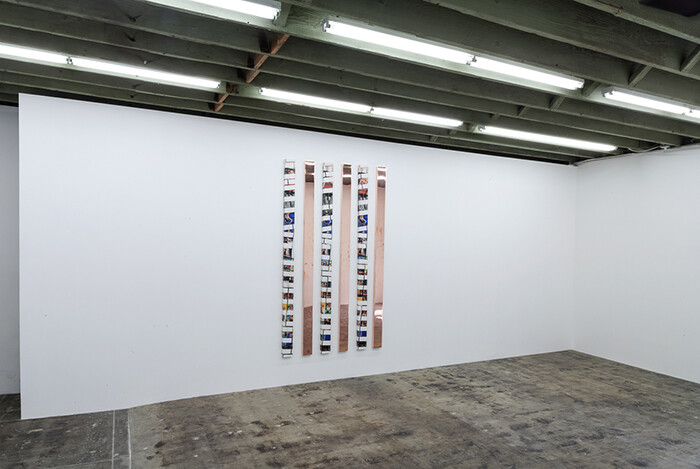The smell of marijuana was really thick in the air at Los Angeles’s Redling Fine Art. “You can get a contact high just walking into this place!” I blurted out to the woman behind the counter. She smiled broadly already stoned? and informed me that the gallery runs exhaust fans pumping out the fumes. Such is the life of the L.A. art gallerist who moves her trade to a Hollywood strip mall adjacent to a weed dispensary.
Now I have never directly suffered from it secondhand, and yet, the Redling hotbox atmosphere added more than mere olfactory assault to the workings of the Walead Beshty and Kelley Walker joint project (pardon the pun) on view. The sense of something illicit, adolescent, perhaps only tamely transgressive—a smoking-pot-in-the-basement, rec-room kind of vibe—runs through the work, tempered by a slickness that only shrewd experience in the art world can buy.
The gallery is entirely bare, save for the collaborative work Hardbodies Software (2014) standing approximately four feet wide by eight feet high on one wall. It intersperses three tall vertical strips of six-inch wide sections of Walker’s so-called “brick” paintings with three similarly-sized sections of Beshty’s copper “surrogates” (the name is lifted from Allan McCollum’s “plaster surrogates”). The Walker paintings contain photographs in tessellated formations, taken from a special series of late-1990s Playboy magazines dedicated to female bodybuilders, while Beshty’s highly-polished, metal slats, like the other works in his ongoing series, are intentionally marked by the handprints of art handlers, who literally take off their gloves to smudge the works during installation. (More such fare can be seen nearby in Beshty’s “Selected Bodies of Work” solo show at Regen Projects.) The commingling of Walker’s and Beshty’s styles—the paintings’ worked and complicated surfaces playing off the reflective, industrially-fabricated surrogates—provides no small visual interest. The fragments of salaciously-presented women appropriated from the glossy pornography of Playboy and the smudged, though still sleek, neo-Judd Minimalist copper objects make fit bedfellows: the handprints on the Beshty portion metonymically stand in for the “dirty” hands touching the magazine’s depiction of oiled-up bodies.
Behind the wall upon which this work hangs is a two-foot wide gap running the length of the gallery, with a narrow aperture at its end; a viewer can just crane her neck to see inside. The framing studs supporting the “false” wall create a cluttered space in which a good-sized chunk of the now-defunct tech magazine Byte’s run is stacked alongside strewn-about VHS sleeves for the 1984 movie Hardbodies, while a copy of Carol J. Adams’ 1990 book The Sexual Politics of Meat (with the period subtitle “A Feminist-Vegetarian Critical Theory”) is tucked away and scarcely visible in the rafters. The Hardbodies film plays on a monitor on a high platform in the crawl space, the screen positioned to face the wall emitting only flickers. The sound, too, is muddied but audible, a subtle clue that this space is secreted behind the wall; however, the film soundtrack competes with the oddly amplified transactions filtering in from the pot shop next door.
According to a synopsis on the Internet Movie Database, the film Hardbodies is the “epitome of a good breast movie”—that innocent genre having been hugely popular in the early 1980s (think of the Porky’s and Revenge of the Nerds movies and their numerous sequels), back when women wore those funny boomerang-shaped bikinis cut really high up on the hips (a look still popular in the Playboy bodybuilder images). These films’ principal misogyny localizes around getting chicks out of their tops so that their tits can bob around before the camera. On the whole, the exhibition takes great pleasure in reproducing pictures of near-naked girls (a visual riff on the original skimpy bikini girl featured in the Hardbodies film’s advertising campaign is a takeaway poster for this show), winking at any possible criticisms by tossing in the early-1990s gender studies reference with Adams. But perhaps guys have to work a bit harder nowadays to avoid reproducing the same values of the works they quote when it comes to mainstream pornography stashed in a rec room. L.A.-based artist Robert Heinecken’s retrospective, which opened at New York’s Museum of Modern Art this past weekend, will undoubtedly give viewers a more complex reckoning with porn, as Heinecken’s work circles around a deep anxiety: that, to the heterosexual male artist, young and lovely female bodies may forever and disappointingly exist only as the slick and disembodied surfaces to be fondled and reconfigured in advertisements and sex magazines. The grubby handprints will only ever be left on the image, and never on the body depicted therein.
“Hardbody Software” is a show that has its cake and gets to eat it too, which is, perhaps, the definition of easily marketable art (girls! mirrors!). It casually employs a palimpsest of appropriations and references as well as the titillation of preening women’s bodies in the nominal service of “critique,” without having a serious stake in transforming much of anything for anyone. The sheer nonchalance of it all is enough to make one nostalgic for the sexisms of the past, when the commitment to maintaining a gendered hierarchy at least expressed itself in weird and passionate ways. Give me a Hans Bellmer any day.











